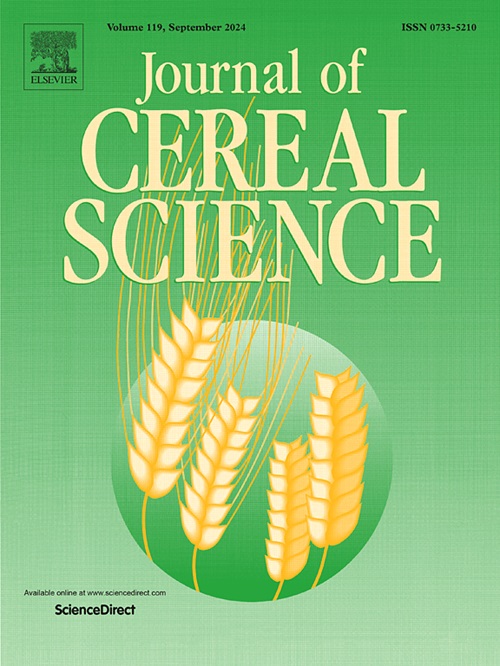Optimizing seed rate improves soft wheat quality, economic returns, and apparent nitrogen recovery with lower nitrogen inputs
IF 3.9
2区 农林科学
Q2 FOOD SCIENCE & TECHNOLOGY
引用次数: 0
Abstract
Grain protein content (GPC) often increases with nitrogen (N) fertilizer; however, low GPC is preferred for soft wheat (Triticum aestivum L.). The combined effects of decreasing N and increasing seed rate (SR) on soft wheat quality, economic benefits (Eb), apparent N recovery (ARN), and soil nitrate-N residual (SNR) are poorly understood. Field experiments were conducted with three SRs (SR135, SR180, and SR225) and two N levels (N235 and N290) in 2017–2018, and three N levels (N290, N235, and N180) with a control (N0) in 2018–19. The results showed that storage proteins, GMP, HMW-GS, and Zeleny sedimentation value significantly decreased with lower N levels and increased with higher SR. At the same SR, the significant difference for the parameters mentioned were greater at a low N rate than at a high rate. Furthermore, grain yield (GY), Eb, ARN, and SNR were significantly affected by N and SR. Increasing SR from 135 to 180 resulted in an average Eb increase of 13.32%, while increasing from 180 to 225 led to a decline of 3.75%. Compared to N290, N235 decreased SNR and GPC by 27.5% and 4.7%, respectively, but increased ARN by 18.3%. The highest Eb (13,914 CNY) and ARN value (57.5%) were observed with the treatment (N235SR180). Additionally, optimal combination for maximizing GY (90%), Eb (87.8%), and ARN (97%) was found at N235SR198, according to regression and spatial analysis. This study confirmed that optimizing N and SR can improve soft wheat quality and resource use efficiency without decreasing yield.

在低氮投入条件下,优化播种率可提高软质小麦品质、经济效益和表观氮回收率
施氮肥往往使籽粒蛋白质含量增加;但软质小麦(Triticum aestivum L.)的GPC较低。减少氮素和增加播种率对软质小麦品质、经济效益、表观氮素恢复率和土壤硝态氮残留量的影响尚不清楚。田间试验于2017-2018年采用SR135、SR180和SR225 3种氮素水平(N235和N290), 2018 - 2019年采用N290、N235和N180 3个氮素水平(N0)。结果表明:贮藏蛋白、GMP、HMW-GS和Zeleny沉降值均随施氮量的降低而显著降低,随施氮量的增加而显著升高。在相同施氮量下,低施氮量显著高于高施氮量。籽粒产量(GY)、Eb、ARN和信噪比均受氮和SR的显著影响,SR从135增加到180,Eb平均增加13.32%,而SR从180增加到225,Eb平均下降3.75%。与N290相比,N235的SNR和GPC分别降低了27.5%和4.7%,ARN提高了18.3%。N235SR180处理的Eb值和ARN值最高,分别为13914 CNY和57.5%。此外,通过回归分析和空间分析,发现N235SR198在最大GY(90%)、Eb(87.8%)和ARN(97%)方面的最优组合。本研究证实,在不降低产量的情况下,优化施氮和施氮量可以提高软质小麦品质和资源利用效率。
本文章由计算机程序翻译,如有差异,请以英文原文为准。
求助全文
约1分钟内获得全文
求助全文
来源期刊

Journal of Cereal Science
工程技术-食品科技
CiteScore
7.80
自引率
2.60%
发文量
163
审稿时长
38 days
期刊介绍:
The Journal of Cereal Science was established in 1983 to provide an International forum for the publication of original research papers of high standing covering all aspects of cereal science related to the functional and nutritional quality of cereal grains (true cereals - members of the Poaceae family and starchy pseudocereals - members of the Amaranthaceae, Chenopodiaceae and Polygonaceae families) and their products, in relation to the cereals used. The journal also publishes concise and critical review articles appraising the status and future directions of specific areas of cereal science and short communications that present news of important advances in research. The journal aims at topicality and at providing comprehensive coverage of progress in the field.
 求助内容:
求助内容: 应助结果提醒方式:
应助结果提醒方式:


